3 Universities & 3 Student Populations Help Define Our Community
| 2015 Q2 | story by ANNE BROCKHOFF |
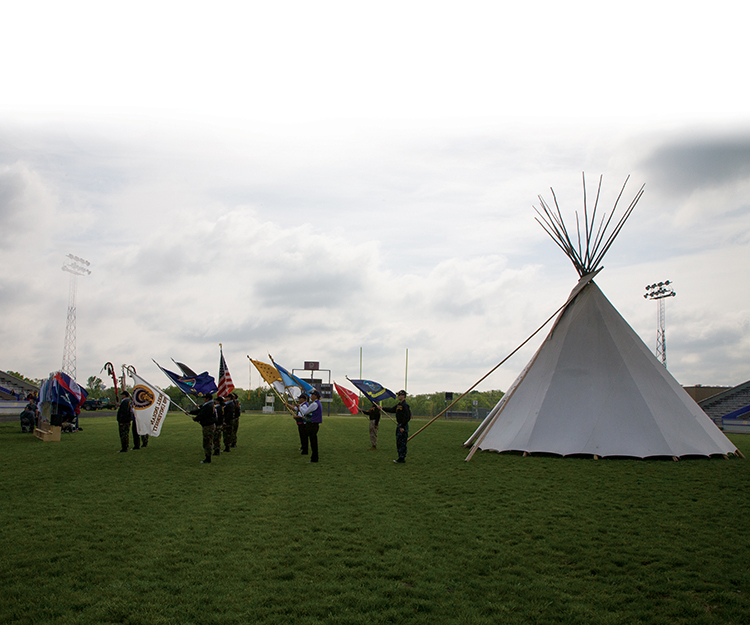
Haskell Indian Nations University graduation ceremony | photo by Steven Hertzog
Driving east on 23rd Street, you might spot the Haskell Indian Nations University sign, or glimpse its stadium. But did you know it draws students from 40 states? And sits on 320 acres? Or that it’s been an integral part of Lawrence for more than 130 years?
You didn’t? Don’t feel bad. Douglas County has three universities, perhaps the highest density in Kansas, and as familiar as they are, there are a lot of folks who don’t know. In fact, Haskell, the University of Kansas and Baker University each contribute to the regional economy and quality of life in ways far beyond the readily visible students, symbols and sports.
“It’s really important to having that community feel and vibe that makes Lawrence a special place,” said Tim Caboni, KU’s Vice Chancellor for Public Affairs.
All three universities were founded in the latter half of the nineteenth century, and each evolved in its own way—KU as a publicly funded research and teaching institution, and Baker as private entity. Perhaps the most unique, though, is Haskell.
When it was formed in 1884, Haskell offered mostly agricultural education to elementary students, but by 1927 was an accredited high school. It evolved into a vocational-technical college, and became Haskell Indian Junior College in 1970. Haskell continued to grow in size and scope and, in 1993, it adopted the current name to reflect its role as a national center for education, research and cultural preservation.
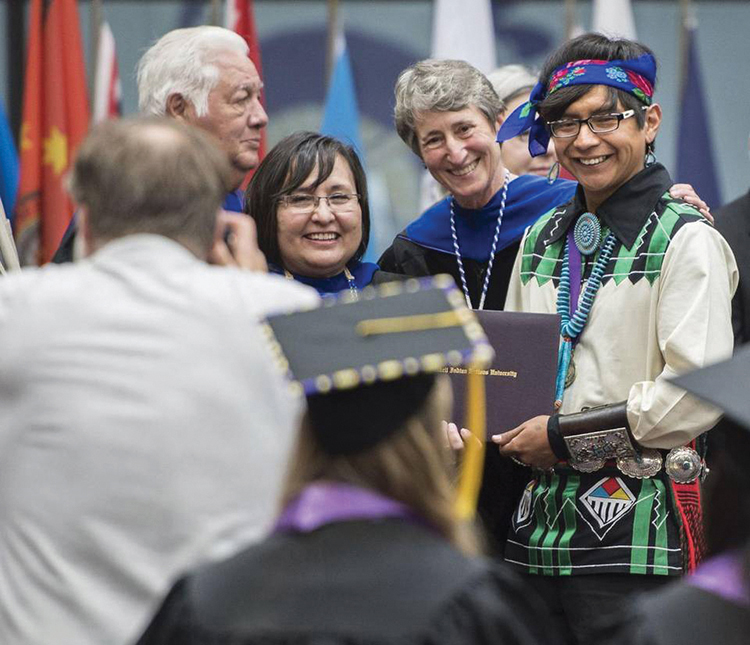
Dr. Chenault with Thomas Zuni on graduation day.
“The length of time Haskell has existed and the changes that have occurred from the way it was originally established and what it’s doing currently—that in itself is an incredible story of resilience and making a difference in a positive way,” said Haskell President Venida Chenault.
Haskell is one of two universities funded by the Bureau of Indian Affairs, and it offers four baccalaureate programs and two associates degrees. It’s a truly intertribal university, with 800 American Indian and Alaska Native students representing 150 tribes from throughout the country. That yields an incredibly rich experience for both students and area residents.
“We have students from back east, from New Jersey, to the Navaho reservation, to the tribes in the Northwest,” Chenault said. “Our experiences, our cultures, our languages, our world views are not all the same.There’s diversity within diversity.”
Many of Haskell’s students return to their tribes to launch economic development initiatives, teach and otherwise contribute to their communities after graduation. In some cases, they help rebuild structures that have collapsed under the weight of poverty, unemployment and other social issues, Chenault said. In others, they help expand the infrastructure, education and programs of thriving tribes. Still other graduates seek jobs and experiences elsewhere.
Haskell is primed to prepare them all.
“We need well-qualified professionals and employees at multiple levels in a number of tribes,” Chenault said. “Haskell is a key player in providing that human capacity.”
Haskell is also an economic driver. Its operating budget of approximately $15 million feeds back into the community through institutional purchases of goods and services. Many of the university’s 200 faculty and employees spend their paychecks here, and the student body, about 95 percent of which lives in on-campus housing, supports local businesses and services.
The university attracts thousands of out-of-towners and alumni to the area, thanks to homecoming, commencement and other events. Haskell’s cultural center, museum and its Indian Art Market (held annually on the second weekend in September) brings in even more, which boosts lodging, food, retail and entertainment revenue.
The university will soon undertake an economic study to better understand Haskell’s impact on Lawrence, and Chenault expects the results to be impressive.
“Most models look at about three times (your budget) in terms of economic impact,” she said. “We do have a footprint.”
That footprint isn’t only financial. Haskell employees and alumni are involved in organizations such as the United Way of Douglas County, Douglas County CASA and Lawrence Cultural Arts Commission, and its administration regularly collaborates with city and county officials on a range of issues.
Haskell partners with KU in student exchanges, music events and its elementary education students work with the Lawrence and Eudora school districts. It’s involved with the GaDuGi SafeCenter, a sexual assault support services provider, and the Willow Domestic Violence Center, both of which operate in Douglas, Franklin and Jefferson Counties. The Haskell Interfaith Council, the Kansas/Haskell LIGHT Campus Ministry, Lawrence Indian United Methodist Church and others fortify relationships between students and the city’s faith groups.
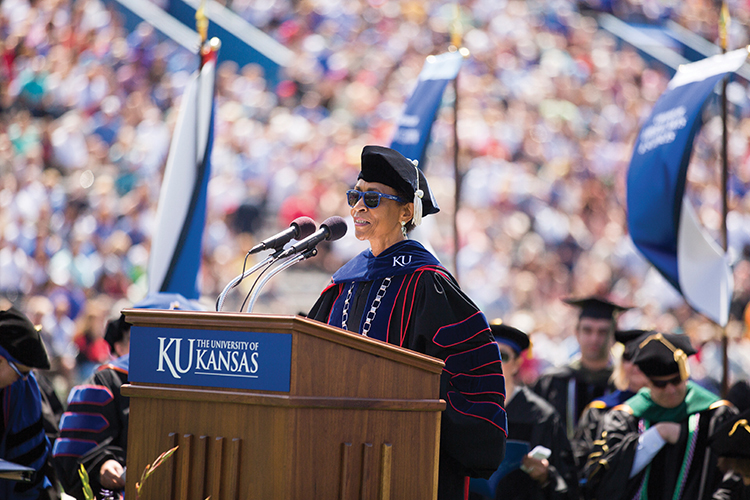
Chancellor Bernadette Gray-Little during KU’s 2015 Commencement Ceremony. photo provided by KU Marketing Communications
“One of my priorities was to build the relationship between Haskell and the community. We’re not done,” Chenault said, who would like to see art walks and other events to bring residents onto campus.
“I want them to understand what we’re doing here, and see how significant this university is nationally,” she said.
Chenault’s is a worthy goal, and it’s one shared by KU.
“We want to get off the hill and be part of Lawrence,” echoes Caboni. “We want Lawrence to know the campus is open and welcoming. We want folks to be part of KU, too.”
Certainly sports are a highlight, as is the Lied Center, Spencer Museum of Art (closed for renovation until mid-2016) and the KU Biodiversity Institute & Natural History Museum. Countless smaller exhibits, events and activities also contribute to Lawrence’s cultural life.
KU faculty, staff and students collaborate on arts, music, dance and theater events, including the Free State Festival in June. They also volunteer, most notably through the annual Big Event. The 2015 version had planned to send 3,600 KU volunteers to 311 job sites across Lawrence before being canceled due to adverse weather. It will return next year, Caboni said.
“It’s just one way the students say thank you to the community that supports us so well,” Caboni said.
KU’s presence also produces measurable gains, including productivity and earnings, knowledge creation, new products and services and an enlarged workforce, according to an economic impact study completed by the Kansas Board of Regents.
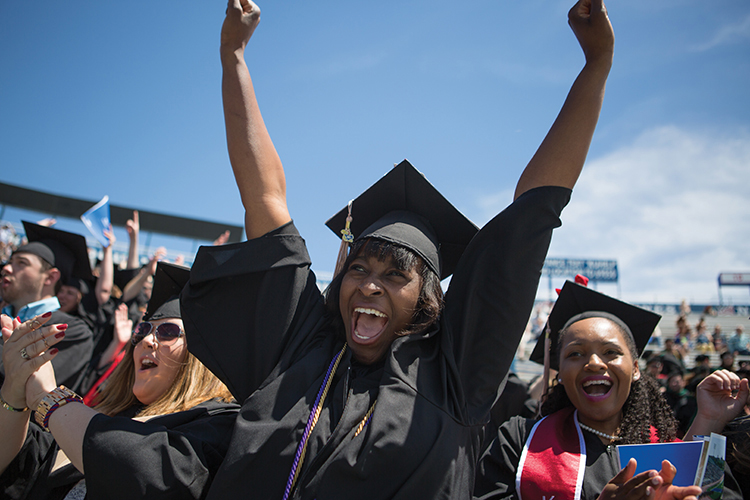
Commencement at KU. photo provided by KU Marketing Communications
The KBOR system’s 32 members, including KU, generated $7.3 billion in sales and $3.4 billion in wages and salaries in 2010, the most recent year for which figures are available. That translates into an $11.94 return on each dollar in state tax support, according to the study.
KU tops the KBOR list when it comes to the scale of that impact. With an operating budget of $863 million in 2010, it had an overall sales impact of $1.8 billion and paid $1 billion in wages and salaries.
“We have a tremendous effect,” Caboni said. “What would the community miss without the $1.8 billion economic impact? Lawrence would be a different place.”
KU is Kansas’ largest employer, Caboni said, and its 13,000 employees include 1,600 faculty at the Lawrence campus; 1,100 at the medical center in Kansas City, Kan.; and more at the Overland Park, Wichita and Salina locations. Thousands of additional staff and employees work to keep all of those facilities and functions running smoothly.
“We generate our own power, maintain a fleet of vehicles, make sure the walls are painted and the grass is mowed, and people are fed,” Caboni said of the main campus. “We do all the things a small town would do.”
KU patronizes local vendors whenever possible, its employees shop here and its 27,983 students contribute through their spending on housing, food, transportation, clothing, entertainment and other goods and services.
The university also helps create new businesses and jobs through efforts like the Bioscience & Technology Business Center (BTBC), which fosters the bioscience and technology industries through a partnership between KU, the City of Lawrence, Douglas County, the Kansas Department of Commerce and the Lawrence Chamber of Commerce.
The BTBC works with everything from private sector start-ups, KU spinouts and student-run enterprises to established companies. Launched in 2010, the BTBC now has 30 tenants that together have 150 employees and an aggregate payroll of more than $8 million, Caboni said.
“This focus on growing our own is going to be very important,” he said.
Other initiatives include KU Innovation & Collaboration, which works with entrepreneurs and corporations to bring technologies and innovations to market, and RedTire, a program that helps rural businesses find successor owners.
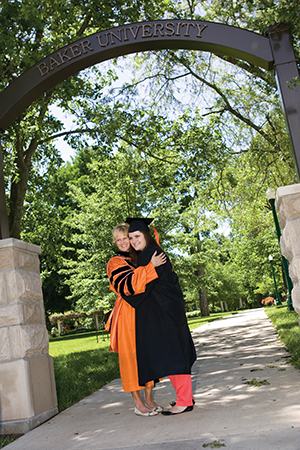
Baker University President, Lynne Murray and May 2015 graduate Kacee Britton under the new House of Hanover Gate. photo provided by Mark Hutchinson.
KU also plays a vital role in the state’s health. In addition to training medical professionals, a variety of programs extend and enrich care in rural and underserved areas. The University of Kansas Cancer Center (the state’s sole National Cancer Institute) is a regional asset, and ongoing research benefits patients in a myriad of ways. Want an example? Eight of the 17 most commonly used cancer drugs were developed at KU, Caboni said.
KU’s 13 schools, including medicine and pharmacy, offer more than 360 degree programs, helping prepare students for a range of careers. It also bolsters workforce readiness through its Dwayne Peaslee Technical Training Center, a partnership between business and industry, the Economic Development Council of Lawrence and Douglas County, City of Lawrence, Douglas County, the Lawrence Chamber of Commerce and Unified School District 497. Its programs range from carpentry and welding to computers, manufacturing and industrial electricity.
Continuing education is also a priority for KU. Its Kansas Law Enforcement Training Center is the state’s central law enforcement training facility, providing basic, specialized and distance learning programs for about 5,000 Kansas officers annually.
KU’s Kansas Fire & Rescue Training Institute staff brings real world training to fire departments with equipment such as a grain engulfment rescue training vehicle that has a grain bin, grain hopper and metal cutting station and can simulate the environment in which most such rescues occur.
“They work with local fire departments to help them learn that if someone falls into a grain silo, there is a very specific way you save that life,” Caboni said. “That’s huge for a state as agriculturally focused as Kansas.”
Baker University, in Baldwin City, is also essential to the regional economy. Founded in 1858, it’s named for Osmon Cleander Baker, a distinguished scholar and bishop of what is now the United Methodist Church, according to Baker’s website. It’s a private university, so funding comes from tuition, investments and private donations rather than taxpayers.
The university had 3,116 students in 2014-15. About a third of those were enrolled in College of Arts and Sciences and School of Education undergraduate programs at its Baldwin City campus, with the remainder attending locations in Kansas and Missouri.
Baker has 751 faculty and staff with a combined payroll of $5.4 million. Murray said 124 of those live in Baldwin and help underpin the local economy. The university itself also patronizes local vendors.
What does that add up to? In answer, Murray pointed to a 2014 report commissioned by the Kansas Independent College Association. According to the report, the KICA’s 18 member colleges and universities had a total payroll of $177.6 million and together spent $181.1 million on goods and services in 2012-13. Some 62 percent of students stay in the state after graduation, and former students employed here added another $720 million to its economy. Out-of-state students contributed $15.6 million to its coffers, while visitors brought in some $14.1 million.
That brings the total effect to $980.8 million, or 0.8 percent of Kansas’ gross state product, according to the report.
The cultural impact is harder to measure, but equally valuable. Baker offers art, theater, music and educational programming during the year, and most of it is free and open to the public, Murray said. Together with athletic events, student orientations and commencements, they bring thousands of visitors to southern Douglas County.
That will likely increase with the opening of the Baker Wetlands Discovery Center later this year. The center will include 900-plus acres, offering miles of trails and a glimpse of Douglas County’s most diverse habitat.
“The center will serve as a tremendous educational resource to Douglas County residents,” Murray said. “People of all ages will have the opportunity to learn more about the wetlands and the natural ecosystem.”
Less visible but no less important are Baker volunteers. In addition to fundraising and events, they work with a wide range of education, church, civic, recreation, athletic, arts, government and health care organizations, Murray said.
“Baker students, administrators, faculty and staff are well known for being active volunteers in their communities,” Murray said. “Baker is valued as a key partner in the communities they serve.”

7 Comments
I really like and appreciate your article post.Much thanks again. Awesome.
Looking forward to reading more. Great blog.Really looking forward to read more. Will read on…
https://snaptik.vip
Hi, I do think this is an excellent blog. I stumbledupon it 😉 I will come back once again since I book marked it. Money and freedom is the greatest way to change, may you be rich and continue to guide other people.
Hello, Neat post. There is an issue along with your website in web explorer, would test this?
IE nonetheless is the marketplace chief and a big part of other people will omit
your magnificent writing because of this problem.
Do you have a spam problem on this blog; I also am a blogger, and I was curious about your situation; many of us have created some nice
methods and we are looking to trade solutions with others, why not shoot me an e-mail
if interested.
Whats up are using WordPress for your site platform?
I’m new to the blog world but I’m trying to get started and
set up my own. Do you require any html coding knowledge to make
your own blog? Any help would be really appreciated!